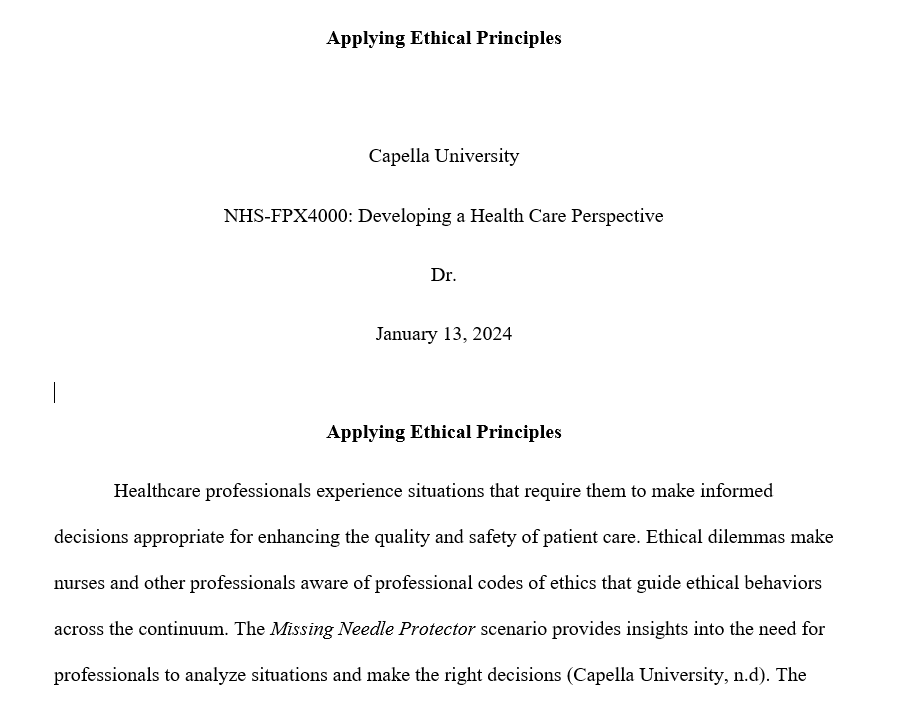Applying Ethical Principles
Capella University
NHS-FPX4000: Developing a Health Care Perspective
Dr.
January 13, 2024
Applying Ethical Principles
Healthcare professionals experience situations that require them to make informed decisions appropriate for enhancing the quality and safety of patient care. Ethical dilemmas make nurses and other professionals aware of professional codes of ethics that guide ethical behaviors across the continuum. The Missing Needle Protector scenario provides insights into the need for professionals to analyze situations and make the right decisions (Capella University, n.d). The events at Hopewell Hospital where the surgical team left a plastic needle protector from a disposable syringe in a patient’s belly demonstrates the need for decisions guided by moral awareness, moral judgment, and ethical behavior.
Reflection of the Missing Needle Protector Case
The situation at Hopewell Hospital reveals one of the serious concerns facing healthcare providers. Despite significant progress made by the director of clinical services in improving quality, the facility faced challenges in terms of hierarchical barriers. The gaps contributed to a general surgeon, with declining physical and mental capacity continuing to handle sensitive surgical procedures (Capella University, n.d). The main issue involved leaving a plastic needle protector from a disposable syringe in a patient’s belly due to claims of challenges seeing if the red-pink object was in the patient’s wound. Straight, the director of clinical services made significant efforts to understand the causes, consequences, and appropriate intervention. The director considered getting the patient back to the operating room while also thinking about the implications of the patient living with the needle protector. The dilemma reinforces the need for healthcare leaders to consider alternatives and made decisions based on actions that match ethical principles of beneficence, justice, and non-maleficence.
Communication Approaches Used in the Case
Ethical dilemmas remind healthcare professionals about communication strategies that guide everyone to make the right decisions. Straight, the director of clinical services understood the need for proactive consultations to uncover the causes, consequences, and evidence-based interventions. As a visionary leader, Straight accommodated suggestions and listened keenly to understand point raised by the scrub nurses, operating room supervisor, and the chief of surgery. The willingness to listen allowed the contacted members of the surgical team to describe events that led to the mistake (Dehghani et al., 2022). Straight elicited honest and transparent conversations about the scenario to form informed conclusions about the preferred action steps. The director also understood the sensitive nature of the error and the likelihood of misleading feedback from the Chief of Surgery, hence the decision to ask a hypothetical question. The approach allowed the director to understand severity of the issue and the need for decisions that match a patient’s best interests.
A negative aspect during the communication approach involved failure to engage Cutrite and hold him accountable, considering the role as a general surgeon and more experienced staff. This way, Straight failed to adopt communication strategies appropriate for breaking power distances and overcoming hierarchical constraints when handling sensitive issues (Dehghani et al., 2022). The communication approaches revealed the need for health leaders to be active listeners, to understand the root causes of problems, and make informed decisions that match a patient’s interests (Fischer- Grönlund et al., 2021). The scenario also highlighted the relevance of leaders with the ability to challenge status quo associated with power structures in a hospital.
The Relevance of Approach used to address the Ethical Dilemma
An error involving the care team leaving an object in a patients belly demonstrates the need for proactive interventions and collaboration among members of the care team. Moral awareness, moral judgment, and ethical behavior guide individuals through the decision-making process (Bakhtiari et al., 2020). In the case, moral awareness is visible after the director listened to the operating room supervisor and understood the need for an informed conclusion about the right action step. The decision to consult and investigate the causes, implications, and corrective measures portrays moral judgment (Rizalar & Baltaci, 2020). The director understood the sensitive nature of the error and the importance of assessing different options and their implications on the future health of the patient (Bakhtiari et al., 2020). Further, ethical behavior is evident in Straight’s decisions after understanding the situation, consulting widely, and familiarizing with the patient’s emotional, physical, and mental wellness in the future. Straight demonstrated the commitment to fulfilling requirements of the decision-making model, which remind health leaders to apply moral awareness, moral judgment, and ethical behavior when faced with an ethical dilemma.
Applying Ethical Principles
The Missing Needle Protector makes healthcare professionals responsive to the principles of beneficence, non-maleficence, justice, and autonomy. The applications of the principles is evident in the scenario. For instance, the director ignored the patient’s autonomy in making decisions that matches her preferences. Denying the patient the right to determine the preferred action step could limit the director from making an informed decision (Kadivar et al., 2017). Secondly, beneficence requires the care team to consider a patient’s best interests before making a decision. In the case, Straight demonstrated desire to make a choice that would protect the patient from harm. However, having a general surgeon with declining capabilities and allowing him to handle sensitive activities raises questions about the facility commitment to fulfilling patients’ best interests.
Reducing Cutrite’s privileges is a priority that would help the hospital make significant progress in enhancing the quality and safety of patient care. The consideration also aligns with the non-maleficence principles that advocate for practices that prevent emotional, psychological, and mental harm (Kadivar et al., 2017). Straight understood the principle of non-maleficence, hence, the decision to seek clarification from the scrub nurse and the chief of surgery before avoiding to take the patient back to the operating room. Lastly, justice principle reminds the care team about delivering fair and equitable services. In this case, Straight made the right decision to handle the situation fairly by investigating and exhausting alternatives available to safeguard the patient from life-threatening complications.
Conclusion
The Missing Needle Protector is an excellent example of a scenario where moral awareness, moral judgment, and ethical behavior allow health leaders to make informed decisions. The case also reminds healthcare providers to embrace the principles of beneficence, non-maleficence, justice, and autonomy. The primary goal is ensuring that decisions meet patients’ expectations and safeguard them from emotional, mental, and physical harm.
References
Bakhtiari, S., Rakhshan, M., Shahriari, M., & Sharif, F. (2020). Perspective and experience of operating room personnel on ethical behaviors. Electronic Journal of General Medicine, 17(3), 1-9. https://www.ejgm.co.uk/download/perspective-and-experience-of-operating-room-personnel-on-ethical-behaviors-7821.pdf
Capella University. (n.d). Ethical Case Studies: The missing needle protector. Capella University. https://media.capella.edu/CourseMedia/nhs4000element18655/wrapper.asp
Dehghani, A., Sobhanian, M., & Jahromi, M.F. (2022). The effect of communication skills training on nurses’ moral distress: A randomized controlled trial. Electronic Journal of General Medicine, 19(6), 1-6. https://www.ejgm.co.uk/download/the-effect-of-communication-skills-training-on-nurses-moral-distress-a-randomized-controlled-trial-12313.pdf
Fischer- Grönlund, C., Brännström, M., Zingmark, Z. (2021). The ‘one to five’ method – A tool for ethical communication in groups among healthcare professionals. Nurse Education in Practice, 51, 1-6. https://www.sciencedirect.com/science/article/pii/S1471595321000342
Kadivar, M., Manookian, A., Asghari, F., Niknafs, N., Okazi, A., & Zarvani, A. (2017). Ethical and legal aspects of patient’s safety: A clinical case report. Journal of Medical Ethics and History of Medicine, 10(15), 1-5. https://www.ncbi.nlm.nih.gov/pmc/articles/PMC6150915/pdf/JMEHM-10-15.pdf
Rizalar, S., & Baltaci, N. (2020). Ethical decision-making levels of nurses and it’s affecting factors. International Journal of Caring Sciences, 13(1), 42-50. https://www.internationaljournalofcaringsciences.org/docs/6_rizarlar_original_13_1.pdf



